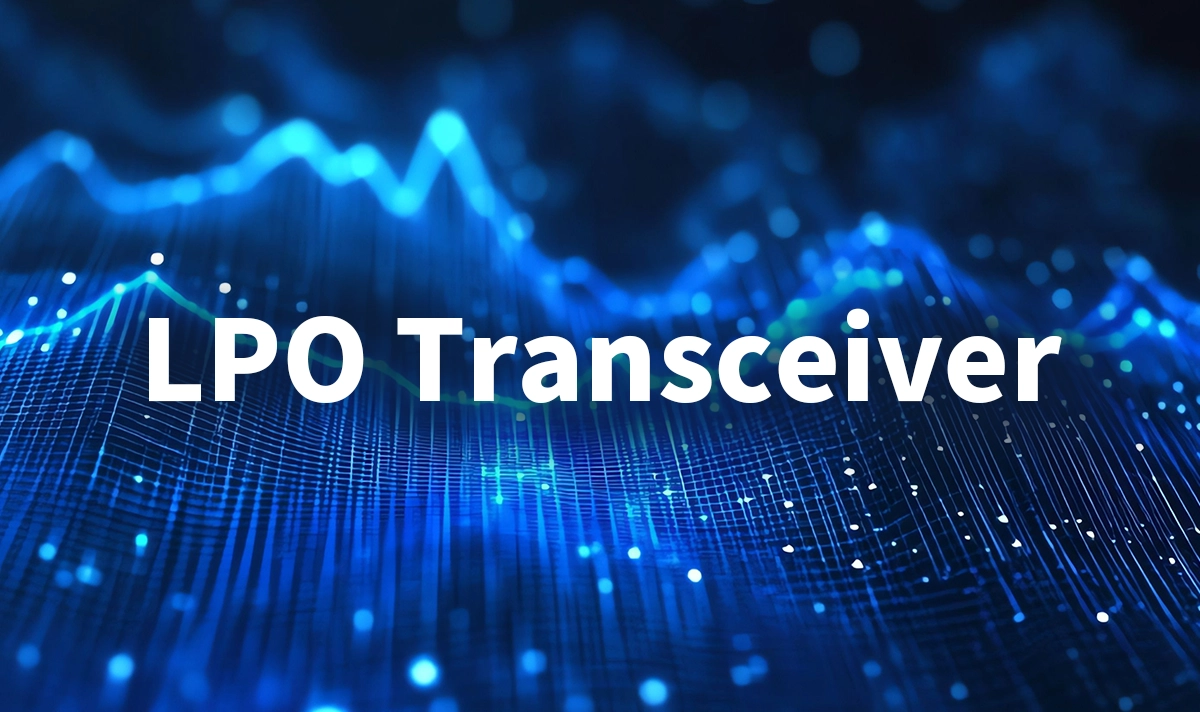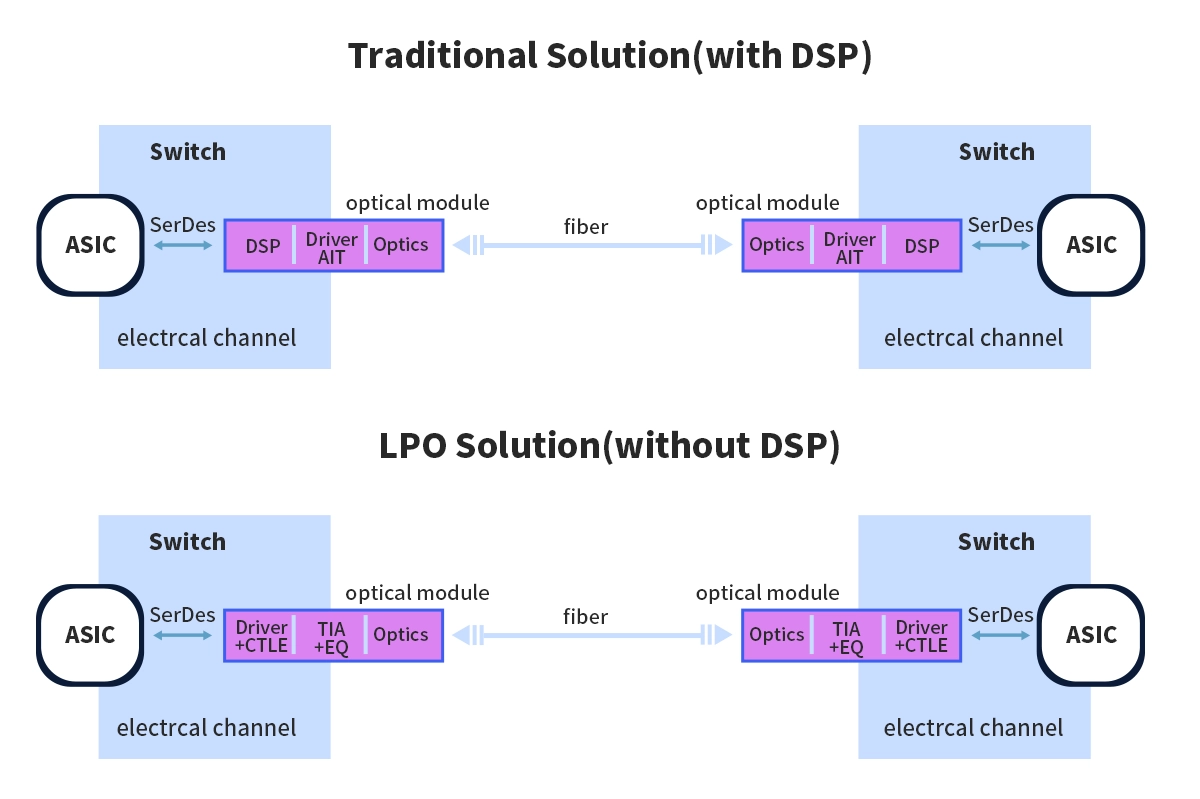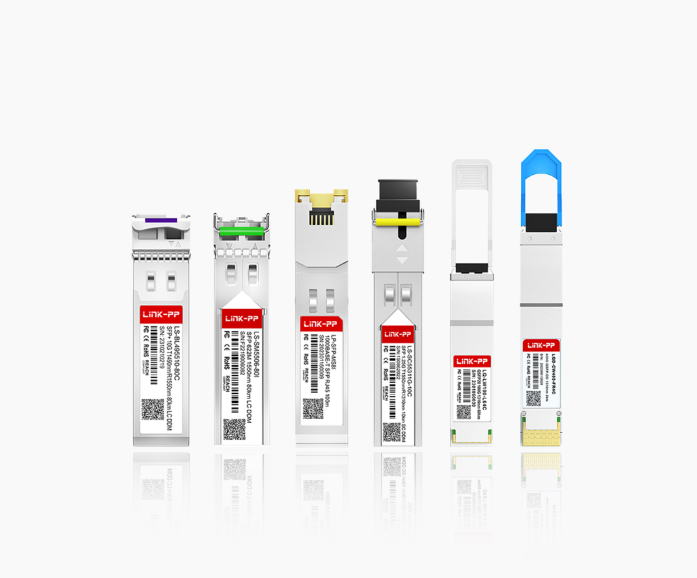
The relentless demand for bandwidth driven by AI, machine learning, and hyperscale computing is pushing data center optical interconnects to their limits. Power consumption and latency have become critical bottlenecks. Enter LPO Optical Modules (Linear Drive/Linear Pluggable Optics), a groundbreaking architecture poised to redefine efficiency and performance. As a optical communications expert, LINK-PP will demystify this transformative technology.
➤ Understanding the LPO Optical Module Architecture
Traditional high-speed optical modules (like 400G and 800G) rely heavily on complex DSP Chips (Digital Signal Processing) within the module. The DSP performs essential but power-hungry functions:
Retiming: Correcting signal timing distortions.
Equalization: Compensating for signal degradation over the fiber/cable.
Forward Error Correction (FEC): Detecting and correcting errors without retransmission.
Gearboxing: Converting between different electrical lane speeds.
While effective, DSP chips come at a cost:
High Power Consumption: DSP is a significant power hog within the optical module, contributing substantially to overall data center energy usage.
Increased Latency: The processing steps introduce valuable nanoseconds of delay – critical in tightly coupled AI/ML training clusters where synchronization is paramount.
Higher Cost: DSP chips add considerable expense to the optical transceiver bill of materials.
Thermal Management: Dissipating the heat generated by the DSP requires complex module designs.
LPO fundamentally changes this paradigm. It eliminates the DSP chip from the optical transceiver itself. Instead:
Simplified Module: The LPO module contains only essential linear analog components (drivers and TIAs - Transimpedance Amplifiers).
Host Dependency: Critical signal conditioning functions (especially sophisticated equalization and potentially some FEC) are moved to the host switch/router's SerDes (Serializer/Deserializer) ASIC.
Collaborative Operation: The host ASIC and the LPO module work in tandem using linear drive signals, enabling high-speed communication without the DSP intermediary.
➤ Why LPO? Key Drivers and Benefits
The move towards LPO optical modules is driven by compelling advantages:
Significantly Lower Power Consumption: This is the primary motivator. Eliminating the DSP chip, often the single largest power consumer in a module, can reduce LPO optical transceiver power consumption by 30-50% compared to equivalent DSP-based modules. This translates directly to lower operating costs (OPEX) and reduced cooling demands in dense data center racks.
Reduced Latency: DSP processing introduces inherent delay. Removing it slashes end-to-end latency, crucial for AI/ML clusters and high-frequency trading where microseconds matter. Expect LPO module latency reduction in the range of several nanoseconds.
Lower Cost: While initial volumes may carry a premium, the simplified design (no expensive DSP chip, potentially smaller form factor) promises a lower LPO transceiver cost structure at scale compared to DSP counterparts.
Simplified Thermal Management: Lower power dissipation eases cooling requirements within the module and the host system, enabling higher port density.
➤ LPO vs. Traditional DSP-Based Modules: A Clear Comparison

Feature | Traditional DSP-Based Module | LPO Optical Module | Advantage for LPO |
|---|---|---|---|
Core Architecture | Includes DSP Chip | No DSP Chip, Linear Analog Components | Simpler Module Design |
Power Consumption | High (DSP is major consumer) | 30-50% Lower | Major OPEX Savings, Cooler Operation |
Latency | Higher (DSP processing delay) | Significantly Lower (ns reduction) | Critical for AI/ML, HPC |
Cost (at scale) | Higher (DSP cost) | Potentially Lower | Lower CAPEX Potential |
Host Dependency | Low (Self-contained signal integrity) | High (Requires advanced host ASIC) | Key Limitation for LPO |
Reach & Compatibility | Robust (Handles various channel impairments) | Limited (Requires short, high-quality links) | Restricts Deployment Scenarios |
Signal Integrity | Managed internally by DSP | Co-optimized between Host ASIC & Module | Requires close host-transceiver partnership |
➤ Key Applications and Deployment Scenarios for LPO Optical Transceivers
LPO excels in environments where the link is short and the host equipment is specifically designed for it:
Data Center Top-of-Rack (ToR) to Leaf Switch Interconnects: Very short distances (typically < 100m, often < 5m).
Intra-Cluster AI/ML & HPC Fabrics: Connecting GPUs/TPUs within a single rack or adjacent racks, where ultra-low latency is paramount.
Co-Packaged Optics (CPO) Alternative: LPO offers a pluggable, less disruptive path to lower power and latency compared to the radical integration of CPO. Consider LPO as a co-packaged optics alternative for near-term deployments.
High-Density Hyperscale Data Centers: Where power savings per module compound massively across thousands or millions of ports.
➤ LINK-PP: Delivering Production-Ready LPO Solutions

Leading optical module manufacturers like LINK-PP are at the forefront of LPO development and deployment. LINK-PP offers robust, standards-compliant LPO optical modules designed for seamless integration with next-generation switches and routers from major vendors.
LINK-PP 400G-LPO-QDD: A high-performance 400G LPO module in the QSFP-DD form factor, ideal for short-reach leaf-spine connections demanding the lowest power and latency. Optimize your AI cluster with this low power 400G optical transceiver.
LINK-PP 800G-LPO-OSFP: Pushing the frontier, this 800G LPO solution targets the most demanding AI backbones within racks, showcasing LINK-PP's commitment to cutting-edge high speed optical connectivity.
➤ Challenges and Considerations for LPO Deployment
LPO isn't a universal panacea. Key considerations include:
Host Dependency & Interoperability: LPO requires the host switch/router ASIC to have exceptionally advanced SerDes capabilities with strong equalization and potentially specific FEC. This creates a tighter coupling between module and host vendor ecosystems compared to DSP-based modules. Ensuring LPO module interoperability is crucial.
Reach Limitations: LPO is primarily suited for very short reaches (typically < 2km, often < 100m). Longer distances or challenging fiber plants still require DSP-based modules.
Signal Integrity Complexity: Offloading equalization to the host requires careful co-design and testing between the module vendor (LINK-PP, etc.) and the switch ASIC vendor. This increases design complexity at the system level.
Ecosystem Maturity: Standards (like the MSA defining LPO specifications) and multi-vendor interoperability are still evolving compared to the mature DSP pluggable market.
➤ The Future of LPO: A Vital Piece of the Puzzle
LPO represents a significant evolution in pluggable optics, directly addressing the power and latency challenges of next-generation data centers and AI infrastructure. While not replacing DSP modules entirely, especially for longer reaches, LPO will become the dominant solution for ultra-short-reach, power-sensitive applications within hyperscale clouds and AI clusters.
Ready to explore how LPO can optimize your data center's power and performance? LINK-PP provides cutting-edge LPO optical transceiver solutions.
➤ FAQ
What makes an LPO transceiver different from a traditional optical module?
LPO transceivers do not have DSP or CDR chips inside. They use a linear-drive design instead. This helps them use less power and make less heat. LPO transceivers also have lower latency. They cost less than traditional modules.
What applications work best with LPO transceivers?
LPO transceivers are best for data centers. They work well for short links in cloud computing and AI. These modules help big server rooms save energy and money.
What are the main benefits of using LPO transceivers?
They use less power
They make less heat
They have lower latency
Upgrades are easy
They are very reliable
LPO modules help data centers save money and energy. They also keep networks running fast.
What are the main limitations of LPO transceivers?
LPO transceivers are best for short or medium distances. They may not work for long links. Some networks might need extra tools to use LPO modules. Not every vendor gives full support for LPO technology.
See Also
The Importance Of Digital Diagnostics In Optical Transceivers




